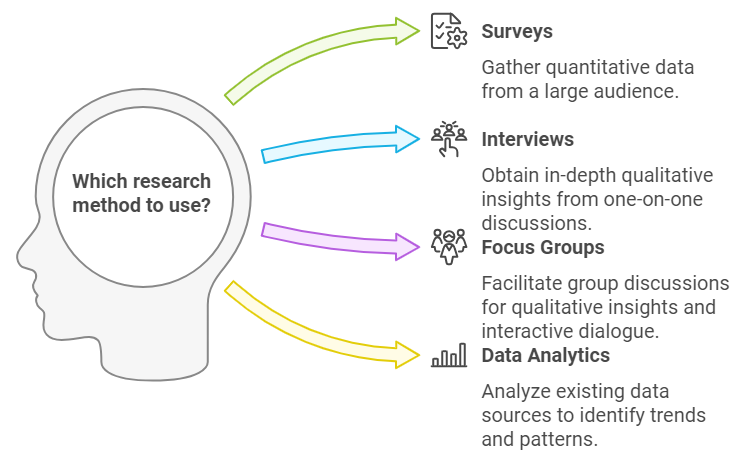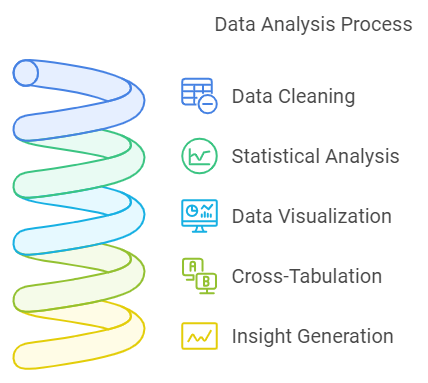Best Practices for B2B Market Research

Is your B2B market research yielding the insights you need to drive success? A good B2B market research strategy offers key insights that guide strategic decisions and shape business development – and by employing effective market research strategies, companies can better understand their target audience, identify emerging opportunities, and refine their offerings to better meet client demands.
What Are the Best Practices for B2B Market Research?

In the world of B2B, effective market research goes beyond simply collecting data; it’s about transforming insights into strategies that drive growth, engagement, and competitive advantage. So, following best practices for B2B market research ensures that your research is comprehensive and aligned with your business’s strategic goals. Here’s a breakdown of the essential practices that lead to successful B2B market research:
1. Define and Understand Your Target Audience
One of the foundational steps in B2B market research is developing a clear understanding of your target audience. This means identifying key demographics, needs, and behaviors within the organizations you’re aiming to serve. By segmenting audiences based on industry, company size, job roles, or even pain points, you ensure your research focuses on the people who matter most to your business. Effective audience definition lets you gather relevant data, creating a solid foundation for actionable insights.
2. Choose the Right Research Methodologies
The methodology you choose can make or break the relevance and quality of your research outcomes. Best practices for B2B étude de marché involve selecting methods that align with your specific goals. Surveys and questionnaires effectively capture large-scale quantitative data, while in-depth interviews and focus groups reveal qualitative insights into buyer motivations and decision-making processes.
3. Focus on High-Quality Data Collection
Accurate, high-quality data is essential to generating actionable insights. Best practices for B2B market research include ensuring data reliability by sourcing information from credible channels, maintaining sample diversity, and verifying data points to prevent biases. Using advanced survey tools and data validation methods ensures that your findings reflect the real dynamics of your market, ultimately leading to better-informed strategies.
4. Incorporate Competitive Intelligence
B2B markets are highly competitive, so understanding your competitors’ strategies is essential. Integrating competitive intelligence into your research process helps you identify gaps in the market and benchmark your performance. This may involve analyzing competitor strengths, pricing strategies, and product positioning. With these insights, you can adjust your offerings and position your brand effectively, ensuring it stands out in the marketplace.
5. Analyze and Interpret Data for Actionable Insights
The true value of market research lies in converting data into actionable insights. Use statistical analysis, data visualization, and trend identification techniques to interpret data in a way that highlights meaningful patterns and actionable opportunities. Presenting insights in a clear, concise format—such as dashboards, visual reports, or executive summaries—ensures that decision-makers can quickly understand the implications and make strategic adjustments.
6. Report Findings with Clarity and Precision
Reporting is a key element of best practices in B2B market research. How you present data influences how effectively your team can act on it. Use visual aids like charts, graphs, and infographics to make complex information more accessible. Tailor reports to the needs of different stakeholders, focusing on actionable recommendations that directly address business objectives.
7. Stay Agile and Adapt to Market Changes
Best practices for B2B market research encourage a flexible approach that adapts to new trends, emerging competitors, and changing customer needs. Continuously monitoring your market and conducting periodic research updates ensures that your strategies remain relevant and effective over time.
However… You Must Choose the Right Research Methodologies

The choice of methods impacts the quality and relevance of the data collected and should align with your research objectives and target audience. Here are key methodologies to consider:
- Surveys help gather quantitative data from a large audience. They can be distributed online, via phone, or through face-to-face interactions. They are effective for measuring attitudes, behaviors, and trends.
- Entretiens: One-on-one discussions provide in-depth qualitative insights. Interviews are ideal for exploring complex topics and understanding individual perspectives.
- Groupes de discussion: Facilitate group discussions to gain qualitative insights into opinions, attitudes, and perceptions. Focus groups can reveal detailed feedback and foster interactive dialogue among participants.
- Analyse des données: Involves analyzing existing data sources to identify trends and patterns. This method leverages big data and advanced analytics tools to derive actionable insights.
And Leverage Emerging Data Analytics and Technology
Incorporating data analytics and technology into your B2B market research strategies can significantly enhance the depth and accuracy of your insights. By harnessing advanced tools and techniques, businesses can analyze vast amounts of data to uncover actionable insights and maintain a competitive edge. Here’s how data analytics and technology can be leveraged effectively:
- Outils d'analyse avancés: Use tools that offer statistical analysis, predictive modeling, and data visualization. These tools help interpret complex data sets and forecast future trends.
- Systèmes de gestion de la relation client (CRM): Integrate CRM data to gain insights into customer behavior, purchase history, and interaction patterns. CRM systems help in understanding client needs and improving customer engagement.
- Exploration de données: Apply data mining to extract valuable patterns and relationships from large datasets. It can reveal hidden trends and inform strategic decisions.
- Artificial Intelligence (AI) and Machine Learning: Implement AI and machine learning algorithms to analyze data, automate processes, and generate predictive insights. These technologies enhance the ability to make data-driven decisions and adapt to market changes.

Implementing Best Practices for B2B Market Research
Executing your B2B market research strategies effectively requires careful planning and execution. Here are best practices to ensure that your research is successful and the findings are actionable:
- Élaborer un plan de recherche: Create a detailed plan outlining your research objectives, methodologies, timelines, and resources.
- Assurer l'exactitude de la collecte de données: Implement quality control measures to ensure that the data collected is accurate and reliable.
- Impliquer les parties prenantes: Impliquez les principales parties prenantes tout au long du processus de recherche pour vous assurer que la recherche répond à leurs besoins et à leurs attentes. Des mises à jour et des séances de rétroaction régulières peuvent aider à aligner la recherche sur les objectifs de l'entreprise.
- Suivre les progrès: Track the progress of your research to ensure it stays on schedule and within budget. Adjustments may be needed if unforeseen issues arise or if the research scope changes.
- Intégrer les résultats à la planification d’entreprise: Ensure that the insights gained from the research are effectively integrated into strategic planning and decision-making processes.
Analyse et interprétation des données

Cette phase transforme les données brutes en informations utiles qui peuvent guider la prise de décision. Voici comment analyser et interpréter efficacement vos données :
- Nettoyage des données: Clean your data to remove any inaccuracies, duplicates, or incomplete entries.
- Analyses statistiques:Utilisez des techniques statistiques pour identifier des modèles, des corrélations et des tendances au sein des données. Des techniques telles que l'analyse de régression, l'analyse factorielle et l'analyse de cluster peuvent fournir des informations plus approfondies.
- Visualisation de données:Créez des diagrammes, des graphiques et des tableaux de bord pour représenter visuellement vos données. La visualisation des données permet de rendre les informations complexes plus accessibles et plus faciles à comprendre.
- Tableau croisé: Analyze relationships between different variables by cross-tabulating data.
- Génération de connaissances: Translate the results of your analysis into actionable insights. Identify key findings that align with your research objectives and business goals.
Prioritizing ROI Measurement for Research Initiatives
In B2B market research, measuring the return on investment (ROI) is essential to understanding the true value of research initiatives and ensuring that resources are well-spent – and here’s how to prioritize ROI measurement in your B2B market research practices.
Set Clear KPIs
The first step to effectively measuring ROI is to define clear goals and key performance indicators (KPIs) before launching any research initiative. By setting specific, measurable objectives—such as increasing customer acquisition, improving product-market fit, or enhancing brand perception—companies create benchmarks that help determine the impact of their research efforts. Establishing KPIs related to these goals ensures that ROI can be accurately assessed once the research is complete.
Track Time and Resources Allocated to Research
Understanding the full cost of each research initiative is crucial for accurate ROI measurement. This includes direct costs, like survey tools, data collection services, consultant fees, and indirect costs, such as staff hours and administrative expenses. By tracking these investments, businesses can compare the total cost of research initiatives with the value they generate, ensuring that only high-impact projects are prioritized.
Connect Research Outcomes to Revenue Metrics
For B2B market research to show real ROI, it must tie directly to revenue-driving outcomes. For instance, if a research initiative leads to a product launch that successfully penetrates a new market, the revenue generated from this product can be partially attributed to the research. Similarly, insights that improve customer retention or sales efficiency should be linked back to specific revenue metrics, helping quantify the financial impact of research on the business.
Evaluate Long-Term Value vs. Immediate Gains
Some research initiatives may not deliver an immediate ROI, yet offer valuable long-term benefits. For example, customer journey analysis might not result in immediate sales but can lead to a better understanding of customer needs, improving customer satisfaction and loyalty over time. To prioritize ROI effectively, consider research projects’ immediate gains and long-term value, creating a balanced view of short-term wins and sustainable growth.
Benchmark Against Industry Standards
Comparing your research ROI with industry benchmarks can provide a valuable perspective on the effectiveness of your initiatives. Many consulting and research firms publish data on the average ROI for B2B market research, offering a reference point to gauge your success. By benchmarking your ROI, you can identify areas for improvement, optimize research processes, and set realistic ROI targets for future initiatives.
How SIS International Helps Businesses Implement Best Practices for B2B Market Research and Techniques
À SIS International, we support businesses in effectively implementing B2B market research strategies and techniques that drive growth and enhance decision-making. Our expertise and tailored services ensure that your market research efforts yield valuable insights and actionable outcomes. Here’s how we assist businesses in achieving their research goals:
Solutions de recherche personnalisées
- We develop bespoke B2B Market Research Strategies aligning with your business objectives and target market. Our approach ensures that the research addresses your unique needs and provides relevant insights.
Advanced-Data Analytics
- We utilize advanced data analytics tools and technologies to analyze complex data sets, uncover trends, and generate actionable insights. Our tools help us make data-driven decisions and stay ahead of market changes.
Comprehensive Support
- SIS provides full support throughout the research process. We focus on translating research findings into practical recommendations that drive business strategies, improve client engagement, and enhance competitive positioning.
Expérience prouvée
- Our track record includes numerous successful projects where our research strategies have led to significant business growth, improved market positioning, and enhanced customer satisfaction.
Notre emplacement à New York
11 E 22nd Street, étage 2, New York, NY 10010 Tél. : +1(212) 505-6805
À propos de SIS International
SIS International propose des recherches quantitatives, qualitatives et stratégiques. Nous fournissons des données, des outils, des stratégies, des rapports et des informations pour la prise de décision. Nous menons également des entretiens, des enquêtes, des groupes de discussion et d’autres méthodes et approches d’études de marché. Contactez nous pour votre prochain projet d'étude de marché.




